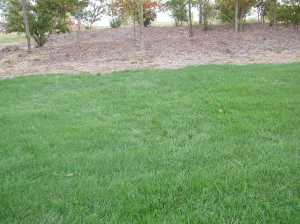Tacoma, Washington, was one of the leading cities in the use of biosolids. The city’s product, Tagro, is classified as Class A – meaning “exceptional quality.” Residents use it in their gardens with great success.1

Where do biosolids come from? Well, the direct source isn’t pretty. It’s processed human waste collected by the wastewater treatment plants. However, the Federal government (EPA) oversees how the biosolids are made and certified*. Biosolids are actually one of the most scientifically studied products for use in agriculture and home gardens. They are tested and certified…something that compost and topsoil sold in garden stores are not subjected to!
So, are biosolids safe? Yes, according to scientific studies.
I’ve been using biosolids in the city of Chicago with the Metropolitan Water Reclamation District of Greater Chicago (MWRDGC) for many years.
One of my latest projects was to “fix” the former U.S. Steel’s South Works site. The soil was comprised of steel mill slag – a substance unsuited for supporting vegetation. Instead of taking out the slag and replacing it with “stolen” soil from another location, we decided to remediate – or fix – the slag with mixtures of dredged sediment and biosolids. Colleagues have also been using them to fix other abandoned sites in Chicago, as well as throughout the United States.2

We used sediments that were already being dredged from Illinois River. On their own, the sediments have poor structure – they would not hold water. They have low nutrient levels for supporting and sustaining quality vegetation. Dredged sediments are usually disposed of. We at MWRDGC felt this was a waste of a good resource, and blended the sediments with Chicago’s own biosolids.
We grew turfgrass on the mixture of biosolids and sediments on the U.S. Steel’s South Works site. Our study showed that the more biosolids in the mixture, the more robust the turf grew. The biosolids provided nutrients to the turf. They increased the soil’s ability to absorb and retain water. Additionally, the biosolids helped eliminate risk from other industrial chemicals on-site.3
Perhaps most importantly, biosolids are teeming with microbial life. Healthy soils can have up to a billion soil microbes in one tablespoon of the soil. Because biosolids are generated from biological process, they are full of these beneficial microbes. Soil microbes help plants get the nutrients they need.4, 5
The site that was once a wasteland of steel slag is now used as recreational space in Chicago, thanks to the use of biosolids. Biosolids are made from something that cities have in abundance. Studies over 40 years have proven them to be safe to use in public spaces. In addition to remediating old polluted sites, biosolids can be used on urban soils to fix severe compaction and low fertility issues. We’ll keep exploring more uses of this processed “locally available renewable resource”…keeping the good nutrients and quality in the cities.
Answered by Lakhwinder Hundal, Metropolitan Water Reclamation District of Greater Chicago.
To receive notices about future blogs, be sure to subscribe to Soils Matter by clicking on the Follow button on the upper right! Explore more on our webpage About Soils. There you will find more information about Soil Basics, Community Gardens, Green Infrastructure, Green Roofs, Soil Contaminants, materials for Teachers and more.
* The EPA protocols for creating biosolids are clear. The biomass produced during the treatment of wastewater is separated from the clean water. A few more processes kill any bacteria lingering in the biomass. The resulting solids are thickened, aged in lagoons, and then air-dried on paved beds. Stabilization and processing make biosolids free of odors and improve handling of the material.
- https://www.soils.org/discover-soils/soils-in-the-city/community-gardens/amending-soil
- https://www.soils.org/discover-soils/story/flushed-resource-restores-ecosystem
- https://www.soils.org/discover-soils/story/city-second-chance-soils
- https://soilsmatter.wordpress.com/2015/07/14/is-it-true-bacteria-live-in-the-soil-isnt-that-bad/
- https://soilsmatter.wordpress.com/2016/02/15/what-is-the-effect-of-leaving-some-of-the-vegetable-crops-up-over-the-winter-how-does-that-improve-soil-conditions/
